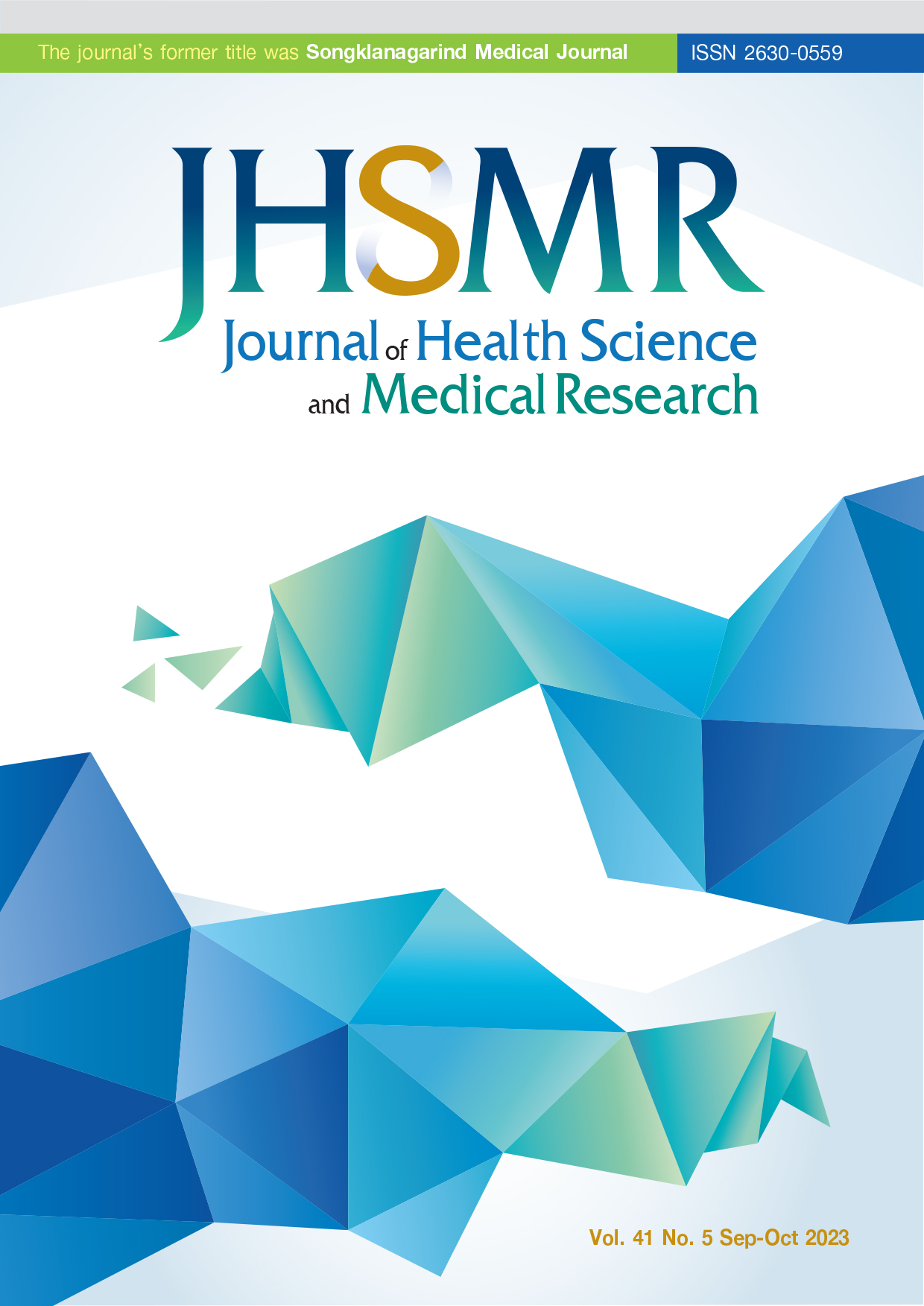Pre-analytical Associated Factors of Foreign DNA Detection Beneath Deceased’s Fingernails
DOI:
https://doi.org/10.31584/jhsmr.2023951Keywords:
associated factor, evidence, fingernails, foreign DNA, forensic DNA, specimen collectionAbstract
Objective: To assess the pre-analytical factors including hand-side, representative collection technique and individual forensic physician for foreign deoxyribonucleic acid (DNA) detection in specimen collected from deceased’s fingernails.
Material and Methods: This cross-sectional study, of an initial 164 samples from the fingernails of both hands, of 82 deceased caseworks; from 2010 to 2018, at the Forensic Unit, Faculty of Medicine, Prince of Songkla University. The autosomal short tandem repeats profile fingernail DNA results, pre-analytical factors, and the deceased’s characteristics were obtained from the records. The fingernail DNA outcomes were evaluated and ranked into five groups, i.e., high-level profile, low-level profile, or residual profile; if foreign alleles of more than 11 alleles, 4 to 11 alleles, or less than 4 alleles were detected, respectively. The non-specific profile group consisted of foreign DNA being detected; however the peak signals were below the decisional threshold. The unidentified group consisted of no foreign DNA being detected. The full model underwent both directional stepwise model selection, and the resulting model with the lowest Akaike information criterion was selected as the final model. The final model was analyzed by ordinal logistic regression for significant associated factors: at a 95% confidence level.
Results: The representative collection technique is an associated factor, via the use of fingernail swabs (adjusted odds ratio (ORa )=13.44, 95% confidence interval (CI)=2.89–62.45), and had a larger effect size than using fingernail cuttings (ORa =6.84, 95% CI=1.47–31.86).
Conclusion: At post-mortem examination, for the collection of foreign DNA from fingernails, the use of fingernail swabs, as a collection technique, is of particular interest.
References
Lazer D. DNA and the criminal justice system: The technology of justice. London: The MIT Press; 2004.
Newton M. The forensic aspects of sexual violence. Best Pract Res Clin Obstet Gynaecol 2013;27:77-90.
Hebda LM, Doran AE, Foran DR. Collecting and analyzing DNA evidence from fingernails: a comparative study. J Forensic Sci 2014;59:1343-50.
Nurit B, Anat G, Michal S, Lilach F, Maya F. Evaluating the prevalence of DNA mixtures found in fingernail samples from victims and suspects in homicide cases. Forensic Sci Int Genet 2011;5:532-37.
Matte M, Williams L, Frappier R, Newman J. Prevalence and persistence of foreign DNA beneath fingernails. Forensic Sci Int Genet 2012;6:236-43.
Cook O, Dixon L. The prevalence of mixed DNA profiles in fingernail samples taken from individuals in the general population. Forensic Sci Int Genet 2007;1:62-8.
Dowlman EA, Martin NC, Foy MJ, Lochner T, Neocleous T. The prevalence of mixed DNA profiles on fingernail swabs. Sci Justice 2010;50:64-71.
Malsom S, Flanagan N, McAlister C, Dixon L. The prevalence of mixed DNA profiles in fingernail samples taken from couples who co-habit using autosomal and Y-STRs. Forensic Sci Int Genet 2009;3:57-62.
Wayne WL. Confidence interval for a proportion in one sample [monograph on the Internet]. Boston: Boston University School of Public Health; 2016 [cited 2020 Oct 21]. Available from: https://sphweb.bumc.bu.edu/otlt/MPH-Modules/PH717-QuantCore/PH717_ConfidenceIntervals-OneSample/PH717_ConfidenceIntervals-OneSample5.html
Chongsuvivatwong V. Ordinal logistic regression. In: McNeil E, editor. Analysis of epidemiological data using R and Epicalc. Songkhla: Chanmuang Press; 2008;p.193-6.
The University of Sydney. Variable selection: stepwise, AIC and BIC [monograph on the Internet]. Camperdown: The University of Sydney; 2020 [cited 2022 Dec 11]. Available from: https://www.maths.usyd.edu.au/u/UG/SM/STAT3022/r/current/Lecture/lecture11_2020JC.html
Hayden DD, Wallin JM. A comparative study for the isolation of exogenous trace DNA from fingernails. Forensic Sci Int Genet 2019;39:119-28.
National Institute of Justice (US). Section D, documenting and evaluating the body, 3. preserve evidence (on body). In: Clark SC. Death investigation: a guide for the scene investigator. Washington, D.C.: U.S. Department of Justice; 2011;p.30.
Fondevila M, Phillips C, Naveran N, Fernandez L, Cerezo M, Salas A, et al. Case report: identification of skeletal remains using short-amplicon marker analysis of severely degraded DNA extracted from a decomposed and charred femur. Forensic Sci Int Genet 2008;2:212-8.
Downloads
Published
How to Cite
Issue
Section
License

This work is licensed under a Creative Commons Attribution-NonCommercial-NoDerivatives 4.0 International License.
























